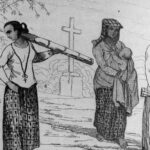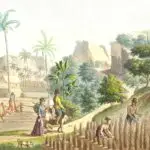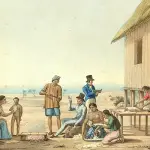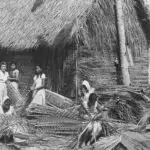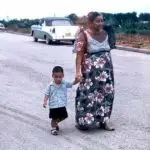CHamoru/Chamorro Women's Legacy of Leadership
Table of Contents
Share This
Kept CHamoru/Chamorro culture alive
CHamoru women have a legacy of leadership that helped keep the culture and history of their people alive. The earliest accounts of ancient CHamoru society state that women maintained their family’s wealth, had final say in the governance of both their home and village and were the primary caretakers of their children and land. CHamoru women assumed powerful roles that were reserved for men in other parts of the world, baffling Spanish missionaries and making it impossible for colonization and genocide to wipe out the CHamoru people, who’ve called the Mariana Islands home for more than 3,500 years.
Determined destiny of their children
CHamoru culture is ancestrally matrilineal; family lines are traced through mothers, grandmothers and great-grandmothers. In ancient CHamoru society, women owned their clan’s land and resources. Since CHamorus were governed under a caste system in which certain clans held more power than others, people’s identity and place in society depended on who their mothers were and which clans they belonged to. The power of each clan depended on the ranking of individual members and the size and quality of their land and ocean resources. While clans owned these resources collectively, only the highest-ranking female members inherited them. Thus, women determined the destiny of their children, and ultimately future generations of CHamorus. They also educated younger CHamorus about their genealogy, ensuring that they would always understand their connections to those around them, and the history of their clan.
Many believe that it is the power of the maternal line that has kept the CHamorus alive. Although CHamorus suffered 26 years of genocide during the Spanish-CHamoru Wars, in which the CHamoru male population was severely reduced, the survival of CHamoru women meant the survival of CHamoru culture. The Spanish did not kill as many CHamoru women as men, but instead attempted to breed them out of existence. This was impossible, however, because the women assumed their ancestral roles and had full power over their children, to whom they passed on CHamoru values and customs.
Worked side by side with men
In order to understand how they were able to maintain the culture, one must look at the roles ancient CHamoru women played before colonization plagued their islands. On a daily basis, women were responsible for taking care of young children, maintaining the household, and tilling and planting in their garden plots. Another important female occupation was the production of woven mats (guafak), which were used for sleeping, hats and other articles. Weaving was documented to be their principal skill and task. Women also made pottery and cooked for their families. They fished within the reef, while men fished outside the reef. Ancient CHamoru families worked together in many ways, and women and men worked equally hard. Side-by-side, women and men cleared the land, planted, cultivated and harvested crops. Women were never behind men, in fact, they usually took the lead in all areas of life.
CHamoru women always had an equal say in all decisions made in ancient CHamoru society. The most powerful woman was the maga’håga, who is said to be the first daughter of the eldest and highest ranking person in a clan. The maga’håga decided where clan members would live, where new villages would be built, and who would marry whom. The maga’håga also participated in clan governance at village council meetings, in which her role was to direct public affairs. Nothing could be done with out the consensus of the maga’håga.
Clan and spiritual leaders
Women were also spiritual leaders, or manmakahna. Several Spanish accounts of the Spanish-CHamoru Wars state that it was the manmakahnas who encouraged CHamoru chiefs to fight Catholicism and Spanish dominance over the island. The Spanish detested these women because they spoke out against their mission and sparked political dissent. Although CHamoru women did not make specific battle decision, they very likely influenced the decision to go to battle. They may have even taken up arms and fought alongside the men, however the Spanish do not document this because they had a strong bias against women in leadership roles.
Most Spanish missionary descriptions of ancient CHamoru women highlight their powerful roles, but many of these accounts do so with a critical eye. Europeans could not understand the unique power CHamoru women assumed, because it worked against their own beliefs. Thus, CHamoru women are not named in early accounts. And while the Europeans equated the highest-ranking male, or maga’låhi, to a chief, they could not find a word for the maga’haga, even though she outranked the maga’låhi.
CHamoru women even defied European concepts of beauty. They are described as being incredibly beautiful, but how they accented this beauty differed greatly from the Spanish. For example, Ancient CHamoru women dyed their teeth black and their hair yellow.
Still revered in CHamoru/Chamorro families
The ultimate testament to the survivability of the CHamoru people today is the continuation of their matrilineal practices. Despite more than 350 years of colonization from patriarchal powers, CHamoru women are still revered as the head of household in most CHamoru families. When children ask their fathers for something, the common reply remains: “Go ask your mother.”
For further reading
Cunningham, Lawrence J. Ancient Chamorro Society. Honolulu: Bess Press, 1992.
Driver, Marjorie G. The Account of Fray Juan Pobre’s Residence in the Marianas, 1602. MARC Miscellaneous Series No. 8. Mangilao: Micronesian Area Research Center, University of Guam, 1993.
Freycinet, Louis Claude de. An Account of the Corvette L’Uraine’s Sojourn at the Mariana Islands, 1819. Translated by Glynn Barratt. Saipan: Commonwealth of the Northern Mariana Islands Division of Historic Preservation, 2003.
Fritz, Georg. The Chamorro: A History and Ethnography of the Mariana Islands. 2nd ed. Translated by Elfriede Craddock and edited by Scott Russell. Occasional Historical Papers Series, No. 1. Saipan: Commonwealth of the Northern Mariana Islands Division of Historic Preservation, 2001.
I Manfåyi: Who’s Who in Chamorro History. Vol. 1. The Hale’-ta Series. Hagåtña: Political Status Education and Coordinating Commission, 1995.
Lévesque, Rodrigue. History of Micronesia: A Collection of Source Documents. Vols. 1-13. Québec: Lévesque Publications, 1992-1998.
Rogers, Robert. Destiny’s Landfall: A History of Guam. Honolulu: University of Hawai’i Press, 1995.
Russell, Scott. Tiempon I Manmofo’na: Ancient Chamorro Culture and History of the Northern Mariana Islands. Saipan: Commonwealth of the Northern Mariana Islands Division of Historic Preservation, 1998.
Souder, Laura Marie Torres. “Unveiling Herstory: Chamorro Women in Historical Perspective.” In Pacific History: Papers from the 8th Pacific History Association Conference. Edited by Donald H. Rubinstein. Mangilao: Micronesian Areas Research Center, University of Guam, 1992.
Souder-Jaffery, Laura Marie Torres. Daughters of the Island: Contemporary Women Organizers of Guam. MARC Monograph Series 1. Mangilao: Micronesian Areas Research Center, University of Guam, 1987.

